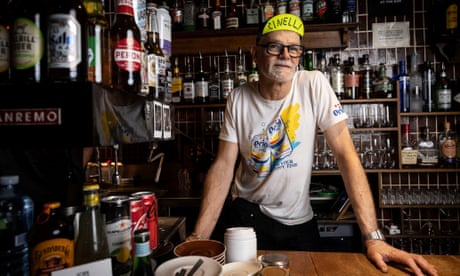- by foxnews
- 08 Apr 2025
‘Time to go back’: city business owners rail against Australia’s working from home shift
‘Time to go back’: city business owners rail against Australia’s working from home shift
- by theguardian
- 25 Apr 2023
- in news

When cafe and small bar owner Dieter Steinbusch puts on one of his favoured khaki shirts, it reminds him of a freedom fighter. He also has a Breton striped top that gets him thinking about the French military.
His inner-city Sydney business endured pandemic lockdowns and then staff shortages, forcing Steinbusch to work more than 100 hours some weeks at his morning espresso-to-nightcap establishment, York Lane.
But that turned out to be the easy part, compared with what came next.
Steinbusch's customers are increasingly working from home, and therefore not drinking or eating at the establishment he has built up over 12 years.
"This is my war," says Steinbusch, who says there has been a 40% drop in trading from pre-pandemic levels.
"Imagine how you'd feel if someone took that amount out of your wage. People are coming up with any excuse not to go to the office. But I'm still here, I'm part of the resistance."
While working from home (or WFH) started as a necessary response to the pandemic, it is now one of its enduring legacies.
The new work arrangements are rattling cities around the world in ways that were unthinkable just a few years ago.
Many office towers are half empty, leaving indebted commercial property owners exposed as leases expire and tenants cut their space requirements. And small businesses that were set up to cater for full buildings are having to adjust to a permanent reduction in foot traffic.
The data shows the phenomenon of online meetings, complete with pet interruptions, zero commutes and working from the kitchen table is now entrenched, especially in major cities like Sydney and Melbourne.
Businesses are two-and-a-half times more likely to offer WFH arrangements to new recruits than they were two years ago, according to Purpose Bureau, an analytics firm that tracks hiring activity.
New businesses are cementing the new way of working.
"The number of WFH offerings from firms opening their doors in the post-Covid era is not only four times higher than older firms but continuing to surge," says Purpose Bureau chief executive Nick Kamper.
"The data shows that workplaces with WFH flexibility enjoy an employee satisfaction premium to those that do not."
While the trend is clear, the Purpose Bureau data - compiled for Guardian Australia - shows disparities between states, with job ads in New South Wales twice as likely to offer WFH arrangements than in South Australia or Tasmania.
Some industries, such as mining, do not tend to offer flexible arrangements due to the nature of their business. Other sectors, including administrative and professional services, have high rates of WFH jobs.
The new arrangements are pressuring commercial landlords, with office vacancy rates now above 13%, representing the higher rate since the 1990s.
Offices are also generally emptier than official data suggests, given a commercial lease for a larger tenant can be 10 years.
While Australian office owners have so far proved resilient, warning bells are ringing overseas. Brookfield, a global office owner, has reportedly just defaulted on a mortgage covering a dozen office buildings - mostly around Washington - amid increasing vacancies.
Default risks are rising in other global cities, including London, as rising borrowing costs and increasing vacancy rates create a toxic mix for commercial landlords.
Economists view weaknesses in the commercial property sector as one of the main looming economic threats.
David Gruen, agency head of the Australian Bureau of Statistics, says the pandemic fast-tracked a shift towards more flexible working arrangements, made possible by technology improvements, especially in video conferencing.
"Certainly for Melbourne and Sydney, where a lot of people have a long commute, it does change the calculus of how many times you're going to come in to work relative to how many times you're going to work from home," says Gruen.
"Whereas it seems to be quite possible there'll be some reversion, it also seems very likely that some of the change will turn out to be permanent."
Home working is heavily weighted towards Mondays and Fridays, with office occupancy higher in the middle of the week.
Some of the financial repercussions of WFH will be that wealth is redistributed, with workers more likely to buy their lunch from their suburban eatery, rather than in the city. There is also an environmental upside that accompanies a reduction in commuting.
Gruen says the impact of any major structural change in society will be cushioned by low unemployment, with levels currently near record lows.
For businesses set up to cater for city workers, the speed of change in working arrangements is alarming.
In 2021, Steinbusch said he could finally see some light at the end of the tunnel after all of the pandemic disruptions.
While the outlook has since dimmed, the bar owner says he's going to have to make his own light.
"When I look back, I won't regret it," he says. "We are going through a major moment as a society. People need a place like this; you can come here for an intelligent conversation. If you stay at home all the time, you are losing life."
He says there's even been talk around the bar about handing customers a little piece of concrete with their coffee, because "everyone needs to toughen up".
"Last Tuesday it rained in the morning so everyone stayed home. I mean, seriously, it's time for them to go back to the office."
- by foxnews
- descember 09, 2016
Ancient settlement reveals remains of 1,800-year-old dog, baffling experts: 'Preserved quite well'
Archaeologists have recently unearthed the remarkably well-preserved remains of a dog from ancient Rome, shedding light on the widespread practice of ritual sacrifice in antiquity.
read more


